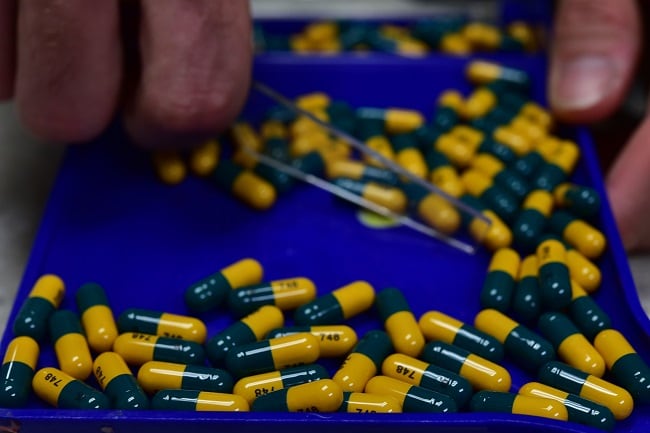A new report of the 100 U.S. cities with the highest rates of sexually transmitted disease lists seven military towns in the top 20, all Air Force and Army installations.
A study published Tuesday by Innerbody.com, a website devoted to medical testing and wellness, ranks 100 cities based on data published last October by the Centers for Disease Control and Prevention on sexually transmitted diseases, including chlamydia, HIV, syphilis and gonnorrhea.
The website looked at city metro areas with populations of 150,000 or more, calculating the overall rates of sexually transmitted diseases and listing the number of cases for each disease. It doesn’t specifically list out military bases, nor make any connection between service members and diseases, but numerous cities on the list are home to some of the country’s largest concentrations of military personnel.
According to the report, Montgomery, Alabama, home to Maxwell Air Force Base, came in at No. 5. Augusta, Georgia, with Fort Gordon, was sixth. At No. 8, Fort Hood’s Killeen, Texas, edged out Shreveport, Louisiana, with Barksdale Air Force Base at No. 9. Fayetteville, North Carolina, home to Fort Bragg, listed as No. 12, while Columbus, Georgia, and Fort Benning, was 15th. Columbia, South Carolina, with Fort Jackson, was 18th.
The overall rate for STDs in Montgomery was 1,731 cases per 100,000 people. For Killeen, it was 1,644 per 100,000, and for Fayetteville, home to the largest U.S. Army post by population, 1,559 per 100,000.
Killeen’s inclusion on the list makes sense to Amanda Robison-Chadwell, director of the Bell County Public Health District, which encompasses the city and Fort Hood. She said while her department has not studied the impact of the base on the county’s STD rates, the average age of the region’s population — 30 — puts it squarely in the population at highest risk.
“The age range at highest risk for transmittal is 15 to 35. We have the demographic. It’s not so much the population of service members as it is the age group,” Robison-Chadwell said.
According to Innerbody, Killeen, with a metro population of more than 350,000 people, had 52 cases of HIV in 2018, 4,190 chlamydia cases, 1,630 gonorrhea cases and 26 cases of syphilis.
“What the trends are nationally, they are usually matched locally. And for us, the STDs we see the most are chlamydia and gonorrhea,” she said.
RELATED

STD cases are on the rise across the general U.S. population and the military services are not immune from this national trend. According to a report released in March by the Armed Forces Health Surveillance Branch, or AFHSB, incidence rates of chlamydia among troops more than doubled from 2013 to 2018, while rates of gonorrhea doubled for men and rose by 33 percent for women.
Diagnoses of syphilis among service members also were nearly three times the number they were a decade ago, according to the AFHSB.
The AFHSB report noted that 349,499 troops were diagnosed with a sexually transmitted illness from 2010 to 2018. This included 212,405 cases of chlamydia, 71,138 cases of human papilloma virus, or HPV, 32,987 cases of gonorrhea, 28,295 cases of genital herpes and 4,674 cases of syphilis.
Across the services, the Army had the highest rates for chlamydia, gonorrhea, and genital herpes simplex virus, while the Navy had the highest overall rate of syphilis and the Air Force, the highest rate of HPV cases.
Robison-Chadwell said that in terms of addressing STDs, prevention is key, given the rise of antibiotic resistant gonorrhea in the U.S. Across the world, other countries are seeing a growing problem with treatment resistant strains of chlamydia, which can cause infertility, and syphilis, which, if not treated, can cause arthritis, blindness, heart disease and dementia.
“What is troubling is that we are seeing an increase in the number of treatment-resistant gonorrhea cases,” Robison-Chadwell said. “People think if they get sick they can just pop a pill and they’ll get better. That’s no longer the case.”
She added that there is a “misnomer out there” that if a person is asymptomatic, they won’t transmit a disease.
“People focus on the symptoms and tend to think if they stay away from someone with symptoms, they won’t get an infection. But they need to know their partners, take precautions and get tested regularly,” Robison-Chadwell said.
According to the Innerbody.com list, the city with the highest STD rate in 2018 was Baltimore, at 2,004 cases per 100,000 population. Rounding out the bottom was Chattanooga, Tenn., with a rate of 794 cases per 100,000.
Other towns with large active-duty military and family populations that made the top 100 include Anchorage, Alaska (27), Jacksonville (45) and Pensacola, (61) in Florida; Norfolk, (54) Virginia; San Antonio, (74) Texas; San Diego (89) and Tucson, (97) Arizona.
Patricia Kime is a senior writer covering military and veterans health care, medicine and personnel issues.




